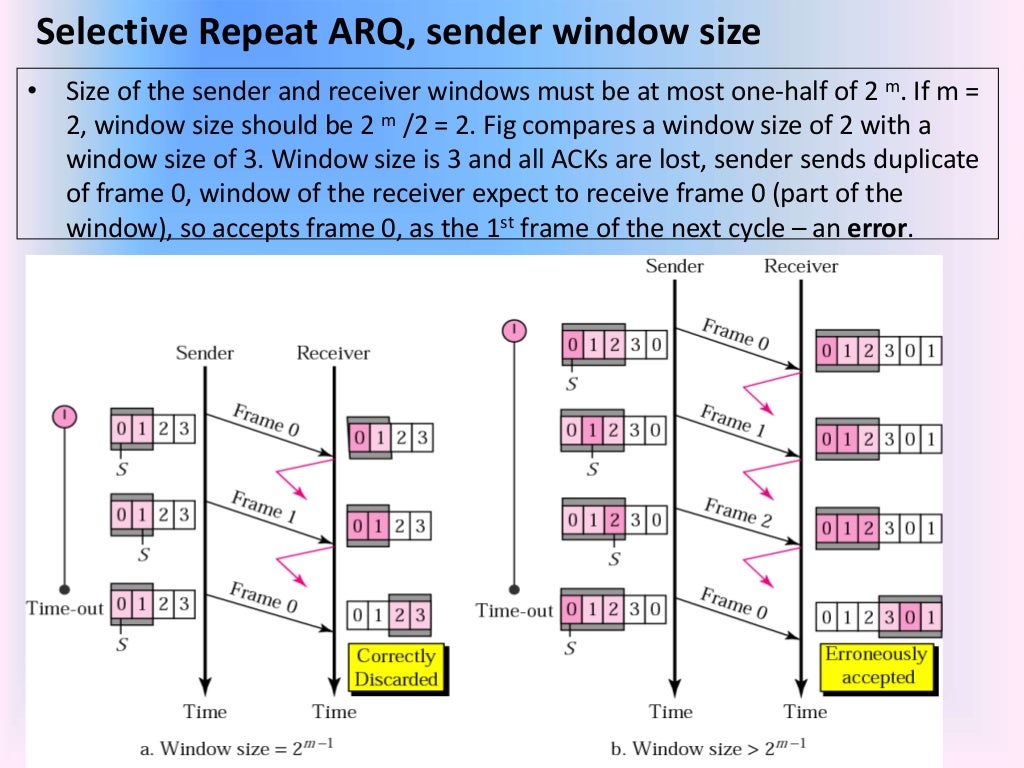
The Minimum Sequence Number in the Selective Repeat protocol is 2N, where N is the number ofpackets transmitted. The Minimum Sequence Number in the Go-Back-N protocol is N+1, where N is the number of packets sent. The minimum sequence number in the Stop and Wait procedure is 2. The Receiver window size in the Selective Repeat technique is N. The Receiver window size in the Go-Back-N protocol is 1. The Receiver window size in the Stop and Wait protocol is 1. The Sender window size in the Selective Repeat technique is N. The Sender window size in the Go-Back-N protocol is N. The Sender window size in the Stop and Wait protocol is 1. The following table highlights the major differences between Stop and Wait, Go-Back-N, and Selective Repeat protocols − Key Difference between Stop and Wait, Go-Back-N, and Selective Repeat Selective Repeat is a better option if you have to be consider bandwidth requirement, as it would resend only the defective or missing packets and not the entire windows. The size of the transmitting window determines the maximum number of frames that can be sent. The size is half of the frame's maximum sequence number.Įven if it does not acknowledge any frame in the interim, the Selective Repeat protocol allows it to send several frames based on the availability of structures in the sending window.

It employs two equal-sized windows: a sending window for storing frames to be sent and a receiving window for storing frames received by the receiver. Particular repetition allows the transmitter to deliver a set number of frames without waiting for individual ACK from the recipient, as in Go-Back-N ARQ. Selective Repeat ARQ is a variant of the automated repeat request (ARQ) protocol used in reliable communications to handle sequence numbers and retransmissions.

If it happens so, then the acknowledgements of all the corresponding packets are lost. Go-Back-N uses cumulative acknowledgements which can reduce the traffic however, there's always a risk of losing the cumulative acknowledgement. If the rate of error is high, then Go-Back-N will consume a lot of bandwidth. Go-Back-N consumes more bandwidth because it would retransmit an entire window even if a single packet is lost. All structures in the current window will be retransmitted if a frame's acknowledgment is not received within the agreed-upon time frame. The maximum number of frames that can be sent at once is entirely dependent on the sender's window size. These numbers are referred to as sequential numbers. The shelves in Go-Back-N ARQ are numbered consecutively because Go-Back-N ARQ provides multiple brackets at once, necessitating a numbering strategy to identify one frame from another. It works on the notion of protocol pipelining, which allows numerous frames to be delivered before the first frame is acknowledged. It can send N frames to the peer before requesting an acknowledgment.

A transmit window size of N, and a receive window size of 1 is a particular case of the basic sliding window protocol. The sender sends several frames determined by a window size even if the receiver does not respond with an acknowledgment (ACK) packet. The Go-Back-N ARQ protocol is a variant of the automatic repeat request (ARQ) protocol. After receiving an acknowledgment (ACK), the sender will send the next data packet to the receiver, and so on, as long as the sender has data to send. The interval between sending a message and receiving an acknowledgment is known as the sender's waiting time, and the sender is idle during this time. The transmitter will come to a halt and wait for the receiver to respond. The transmitter sends one frame at a time to the receiver using this method. It is the most fundamental flow control strategy. Read through this article to get a basic overview of Stop and Wait, Go-Back-N, and Selective Repeat protocols. All these three protocols provide a mechanism for flow control.


 0 kommentar(er)
0 kommentar(er)
